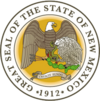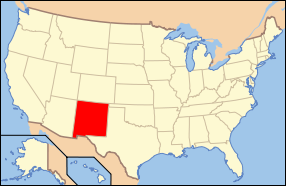New Mexico
| State of New Mexico | |||||||||||
|
|||||||||||
| Official language(s) | None | ||||||||||
| Demonym | New Mexican | ||||||||||
| Capital | Santa Fe | ||||||||||
| Largest city | Albuquerque | ||||||||||
| Largest metro area | Albuquerque Rio Grande Valley | ||||||||||
| Area | Ranked 5th in the US | ||||||||||
| - Total | 121,665 sq mi (315,194 km²) |
||||||||||
| - Width | 342 miles (550 km) | ||||||||||
| - Length | 370 miles (595 km) | ||||||||||
| - % water | 0.2 | ||||||||||
| - Latitude | 31° 20′ N to 37° N | ||||||||||
| - Longitude | 103° W to 109° 3′ W | ||||||||||
| Population | Ranked 36th in the US | ||||||||||
| - Total | 1,969,915 (2007 est.)[1] | ||||||||||
| - Density | 16.2/sq mi (6.27/km²) Ranked 45th in the US |
||||||||||
| Elevation | |||||||||||
| - Highest point | Wheeler Peak[2] 13,161 ft (4,011 m) |
||||||||||
| - Mean | 5,692 ft (1,735 m) | ||||||||||
| - Lowest point | Red Bluff Reservoir[2] 2,842 ft (866 m) |
||||||||||
| Admission to Union | January 6, 1912 (47th) | ||||||||||
| Governor | Bill Richardson (D) | ||||||||||
| Lieutenant Governor | Diane Denish (D) | ||||||||||
| U.S. Senators | Pete Domenici (R) Jeff Bingaman (D) |
||||||||||
| Congressional Delegation | List | ||||||||||
| Time zone | Mountain: UTC-7/-6 | ||||||||||
| Abbreviations | NM US-NM | ||||||||||
| Website | www.newmexico.gov | ||||||||||
New Mexico (/nuːˈmɛksɨkoʊ/, Spanish: Nuevo México) is a state located in the southwestern region of the United States of America. It has been inhabited by Native American populations and has been part of the Imperial Spanish viceroyalty of New Spain, part of Mexico, and a U.S. territory. Among U.S. states, New Mexico has the highest percentage of Hispanic Americans at 43%, comprising both recent immigrants and descendants of Spanish colonists.[3] It also has the third-highest percentage of Native Americans after Alaska and Oklahoma, and the fifth-highest total number of Native Americans after California, Oklahoma, Arizona, and Texas.[4] The tribes represented in the state consist of mostly Navajo and Pueblo peoples. As a result, the demographics and culture of the state are unique for their strong Spanish, Mexican, and American Indian cultural influences. The climate of the state is highly arid and its territory is mostly covered by mountains and desert. At a population density of 15 per square mile, New Mexico is the sixth most sparsely inhabited U.S. State.
Contents |
Geography
- Further information: List of New Mexico counties


The state's total area is 121,665 square miles (315,110 km2). The eastern border of New Mexico lies along 103° W longitude with the state of Oklahoma, and three miles (5 km) west of 103.5° W longitude with Texas. On the southern border, Texas makes up the eastern two-thirds, while the Mexican states of Chihuahua and Sonora make up the western third, with Chihuahua making up about 90% of that. The western border with Arizona runs along the 109° 03' W longitude. The 37° N latitude parallel forms the northern boundary with Colorado. The states New Mexico, Colorado, Arizona, and Utah come together at the Four Corners in the northwestern corner of New Mexico. New Mexico, although a large state, has little water. Its surface water area is only about 250 square miles (650 km2). New Mexico's average precipitation rate is only 15 inches (380 mm) a year.
The landscape ranges from wide, rose-colored deserts to broken mesas to high, snow-capped peaks. Despite New Mexico's arid image, heavily forested mountain wildernesses cover a significant portion of the state, especially towards the north. The Sangre de Cristo Mountains, the southernmost part of the Rocky Mountains, run roughly north-south along the east side of the Rio Grande (Big River) in the rugged, pastoral north. The most important of New Mexico's rivers are the Rio Grande, Pecos, Canadian, San Juan, and Gila. The Rio Grande is the eighth longest river in the U.S.
Creosote bush, mesquite, cacti, yucca, and desert grasses, including black grama, purple three-awn, tobosa, and burrograss, cover the broad, semiarid plains that cover the southern portion of the state.
The Federal government protects millions of acres of New Mexico as national forests including:
- Carson National Forest
- Cibola National Forest (headquartered in Albuquerque)
- Lincoln National Forest
- Santa Fe National Forest (headquartered in Santa Fe)
- Gila National Forest
- Gila Wilderness
Areas managed by the National Park Service include:[5]
- Aztec Ruins National Monument at Aztec
- Bandelier National Monument in Los Alamos
- Capulin Volcano National Monument near Capulin
- Carlsbad Caverns National Park near Carlsbad
- Chaco Culture National Historical Park at Nageezi
- El Camino Real de Tierra Adentro National Historic Trail
- El Malpais National Monument in Grants
- El Morro National Monument in Ramah
- Fort Union National Monument at Watrous
- Gila Cliff Dwellings National Monument near Silver City
- Old Spanish National Historic Trail
- Pecos National Historical Park in Pecos
- Petroglyph National Monument near Albuquerque
- Salinas Pueblo Missions National Monument at Mountainair
- Santa Fe National Historic Trail
- White Sands National Monument near Alamogordo
Visitors also frequent the surviving native pueblos of New Mexico. Tourists visiting these sites bring significant monies to the state. Other areas of geographical and scenic interest include Kasha-Katuwe Tent Rocks National Monument and the Valles Caldera National Preserve. The Gila Wilderness lies in the southwest of the state.
- See also: Delaware Basin
History

The first known inhabitants of New Mexico were members of the Clovis culture of Paleo-Indians.[6] Later inhabitants include Native Americans of the Mogollon and the Anasazi cultures.[7] By the time of European contact in the 1500s, the region was settled by the villages of the Pueblo peoples and groups of Navajo, Apache and Ute.[6]
Francisco Vasquez de Coronado assembled an enormous expedition at Compostela in 1540–1542 to explore and find the mystical Seven Golden Cities of Cibola as described by Fray Marcos de Niza.[7] Juan de Oñate was appointed the first governor of the new Province of New Mexico in 1598.[7] In 1598 he founded the San Juan de los Caballeros colony, the first permanent European settlement in the future state of New Mexico,[8] on the Rio Grande near Ohkay Owingeh Pueblo.[7] Oñate extended El Camino Real de Tierra Adentro, "Royal Road of the Interior," by 700 miles (1,100 km) from Santa Bárbara, Chihuahua to his remote colony.[9]
The settlement of Santa Fe was established at the foot of the Sangre de Cristo Mountains around 1608.[9] The city, along with most of the settled areas of the state, was abandoned by the Spanish for 12 years (1680–1692) as a result of the successful Pueblo Revolt. After the death of the Pueblo leader Popé, Diego de Vargas restored the area to Spanish rule.[7] While developing Santa Fe as a trade center, the returning settlers founded Albuquerque in 1706 from existing surrounding communities,[7] naming it for the viceroy of New Spain, Francisco Fernández de La Cueva Enríquez, 10th Duke of Alburquerque.[10]

As a part of New Spain, the claims for the province of New Mexico passed to independent Mexico in 1821 following the Mexican War of Independence.[7] The Republic of Texas claimed the mostly vacant territory north and east of the Rio Grande when it successfully seceded from Mexico in 1836.[11] The extreme northeastern part of New Mexico was originally ruled by France, and sold to the United States as part of the Louisiana Purchase in 1803.[12]
Following the Mexican-American War, from 1846-1848 and the Treaty of Guadalupe Hidalgo in 1848, Mexico ceded its mostly unsettled northern holdings, today known as the American Southwest and California, to the United States of America.[7] In the Compromise of 1850 Texas ceded its claims to the area lying east of the Rio Grande in exchange for ten million dollars.[7] The United States acquired the southwestern boot heel of the state and southern Arizona below the Gila river in the mostly desert Gadsden Purchase of 1853.[7]
Congress admitted New Mexico as the 47th state in the Union on January 6, 1912.[7]
During World War II, the first atomic bombs were designed and manufactured at Los Alamos and the first was tested at Trinity site in the desert on the White Sands Proving Grounds between Socorro and Alamogordo.[7]
New Mexico has benefited from federal government spending. It is home to three Air Force bases, White Sands Missile Range, and the federal research laboratories Los Alamos National Laboratory and Sandia National Laboratories. The state's population grew rapidly after World War II, going from 531,818 in 1940 to 1,819,046 in 2000.[13][14] Employment growth areas in New Mexico include microelectronics, call centers, and Indian casinos.[15]
Demographics
- See also: List of cities in New Mexico and New Mexico locations by per capita income
Population

As of 2005, New Mexico has an estimated population of 1,928,384, which is an increase of 25,378, or 1.3%, from the prior year and an increase of 109,338, or 6.0%, since the year 2000. This includes a natural increase since the last census of 74,397 people (that is 143,617 births minus 69,220 deaths) and an increase due to net migration of 37,501 people into the state. Immigration from outside the United States resulted in a net increase of 27,974 people, and migration within the country produced a net increase of 9,527 people.
The center of population of New Mexico is located in Torrance County, in the town of Manzano.[16]
7.2% of New Mexico's population was reported as under 5 years of age, 28% under 18, and 11.7% were 65 or older. Females make up approximately 50.8% of the population.
As of 2006, 8.2% of the residents of the state were foreign-born.
New Mexico's July 1, 2007 population was estimated at 1,969,915 by the United States Census Bureau's Population Estimates Program.[14]
| Historical populations | |||
|---|---|---|---|
| Census | Pop. | %± | |
| 1850 | 61,547 |
|
|
| 1860 | 93,516 | 51.9% | |
| 1870 | 91,874 | −1.8% | |
| 1880 | 119,565 | 30.1% | |
| 1890 | 160,282 | 34.1% | |
| 1900 | 195,310 | 21.9% | |
| 1910 | 327,301 | 67.6% | |
| 1920 | 360,350 | 10.1% | |
| 1930 | 423,317 | 17.5% | |
| 1940 | 531,818 | 25.6% | |
| 1950 | 681,187 | 28.1% | |
| 1960 | 951,023 | 39.6% | |
| 1970 | 1,017,055 | 6.9% | |
| 1980 | 1,303,302 | 28.1% | |
| 1990 | 1,515,069 | 16.2% | |
| 2000 | 1,819,046 | 20.1% | |
| Est. 2007 | 1,969,915 | [14] | 8.3% |
| Sources: 1850–1990,[13] 2000[14] | |||
Important cities & counties
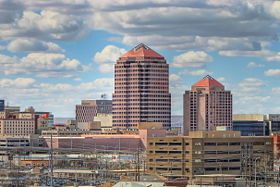
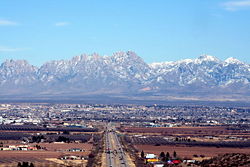


| Rank | City | County | Population |
|---|---|---|---|
| 1 | City of Albuquerque | Bernalillo County | 518,271 |
| 2 | City of Las Cruces | Dona Ana County | 89,722 |
| 3 | City of Rio Rancho | Sandoval County | 75,978 |
| 4 | City of Santa Fe | Santa Fe County | 73,199 |
| 5 | City of Roswell | Chaves County | 45,569 |
| 6 | City of Farmington | San Juan County | 42,425 |
| 7 | City of Alamogordo | Otero County | 35,607 |
| 8 | City of Clovis | Curry County | 33,182 |
| 9 | City of Hobbs | Lea County | 29,602 |
| 10 | City of Carlsbad | Eddy County | 25,033 |
| Rank | County | Population within county limits |
Land Area sq. miles |
Population Density per sq mi |
Largest city |
|---|---|---|---|---|---|
| 1 | Bernalillo County | 629,292 | 1,166 | 540 | Albuquerque |
| 2 | Doña Ana County | 198,791 | 3,807 | 52 | Las Cruces |
| 3 | Santa Fe County | 142,955 | 1,909 | 75 | Santa Fe |
| 4 | San Juan County | 122,427 | 5,514 | 22 | Farmington |
| 5 | Sandoval County | 117,866 | 3,710 | 32 | Rio Rancho |
Race & ancestry
According to the Census Bureau, 1.5% of the population is Multiracial/Mixed-Race, a population larger than both the Asian and NHPI population groups. In 2004 New Mexico had the highest percentage (43%) of Hispanics of any state, some recent immigrants and others descendants of Spanish colonists.[3] The state also has a large Native American population, third, in percentage, behind Alaska and Oklahoma. Hispanics of colonial ancestry, along with recent Mexican immigrants, are present in most of the state, especially northern, central, and northeastern New Mexico. Mexican immigrants, legal or illegal, are prominent in southern parts of the state. Descendants of white American settlers, mostly of Irish English, and Spanish descent, from other parts of United States live in west, southwest, and southeast areas and main cities of the state. The northwestern corner of the state is primarily occupied by Native Americans, of which Navajos and Pueblos are the largest tribes. As a result, the demographics and culture of the state are unique for their strong American, Colonial Spanish, Mexican, and Native American cultural influences.
According to estimates from the United States Census Bureau's Population Estimate Program,[19] on July 1, 2007 the population of New Mexico was 1,969,915, and the number of New Mexicans of these single races were: White, 1,663,821 (84.46%); Black, 56,083 (2.85%); American Indian or Alaskan Native, 186,256 (9.46%); Asian, 27,722 (1.41%); and Native Hawaiian or Pacific Islander, 2,787 (0.14%). There were 33,246 (1.69%) of two or more races. There were 874,688 (44.40%) Hispanics.
According to the 2000 United States Census,[20] the most commonly claimed ancestry groups in New Mexico were: Mexican (16.3%), American Indian (10.3%), German (9.8%), Hispanic (9.4%), and Spanish (9.3%).
Languages
According the 2000 U.S. Census, 28.76% of the population aged 5 and over speak Spanish at home, while 4.07% speak Navajo.[21]
New Mexico is commonly thought to have Spanish as an official language alongside English, due to the widespread usage of Spanish in the state. Although the original state constitution of 1912 provided for a temporarily bilingual government, New Mexico has no official language. Nevertheless, the state government publishes a driver's manual as well as ballots in both languages (they are required to publish ballots in Spanish by federal law).
The constitution provided that, for the following twenty years, all laws passed by the legislature be published in both Spanish and English, and thereafter as the legislature should provide.
Prior to 1967, notices of statewide and county elections were required to be printed in English and "may be printed in Spanish." Additionally, many legal notices today are required to be published in both English and Spanish.[22]
In 1995, New Mexico adopted a "State Bilingual Song," titled "New Mexico - Mi Lindo Nuevo México."
Religion
Religious affiliations
According to a report compiled by the Association of Statisticians of American Religious Bodies, the largest denominations in 2000 were the Catholic Church with 670,511; the Southern Baptist Convention with 132,675; the Church of Jesus Christ of Latter-day Saints with 42,261; and the United Methodist Church with 41,597 adherents.[23] According to a 2008 survey by the Pew Research Center, the most common self-reported religious affiliation of New Mexico residents are:[24]
- Roman Catholic – 26%
- Evangelical Christian denominations – 25%
- Unaffiliated – 21%
- Mainline Protestant – 15%
- Other affiliations – 12%
- No answer – 1%
Catholic Church hierarchy
Within the hierarchy of the Catholic Church, New Mexico belongs to the Ecclesiastical Province of Santa Fe. New Mexico has three dioceses, one of which is an archdiocese:
- Archdiocese of Santa Fe
- Diocese of Gallup
- Diocese of Las Cruces
Economy
Oil and gas production, tourism, and federal government spending are important drivers of the state economy. State government has an elaborate system of tax credits and technical assistance to promote job growth and business investment, especially in new technologies.
Economic indicators
In 2007 New Mexico's Gross Domestic Product was $76.178 billion (preliminary figure).[25] In 2007 the per capita personal income was $31,474 (rank 43rd in the nation).[26] In 2005 the percentage of persons below the poverty level was 18.4%.[27] The New Mexico Tourism Department estimates that in Fiscal Year 2006 the travel industry in New Mexico generated expenditures of $6.5 billion.[28]
Oil & gas production
New Mexico is a leading crude oil and natural gas producer in the United States. The Permian Basin (part of the Mid-Continent Oil Field) and San Juan Basin lie partly in New Mexico. In 2006 New Mexico accounted for 3.4% of the crude oil, 8.5% of the dry natural gas, and 10.2% of the natural gas liquids produced in the United States.[29] In 2000 the value of oil and gas produced was $8.2 billion.[30]
Federal government
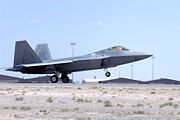
Federal government spending is a major driver of the New Mexico economy. In 2005 the federal government spent $2.03 on New Mexico for every dollar of tax revenue collected from the state. This rate of return is higher than any other state in the Union.[31]
Many of the federal jobs relate to the military; the state hosts three air force bases (Kirtland Air Force Base, Holloman Air Force Base, and Cannon Air Force Base); a testing range (White Sands Missile Range); and an army proving ground and maneuver range (Fort Bliss - McGregor Range). A May 2005 estimate by New Mexico State University is that 11.65% of the state's total employment arises directly or indirectly from military spending.[32] Other federal installations include the technology labs of Los Alamos National Laboratory and Sandia National Laboratories.
Economic incentives
New Mexico provides a number of economic incentives to businesses operating in the state, including various types of tax credits and tax exemptions. Most of the incentives are based on job creation.[33]
New Mexico law allows governments to provide land, buildings, and infrastructure to businesses to promote job creation. Several municipalities have imposed an Economic Development Gross Receipts Tax (a form of Municipal Infrastructure GRT) that is used to pay for these infrastructure improvements and for marketing their areas.[34]
The state provides financial incentives for film production.[35][36] The New Mexico Film Office estimated at the end of 2007 that the incentive program had brought more than 85 film projects to the state since 2003 and had added $1.2 billion to the economy.[37]
State taxes
Beginning in 2008, personal income tax rates for New Mexico range from 1.7% to 4.9%, within four income brackets.[38] Beginning in 2007, active-duty military salaries are exempt from the state income tax.[39]
New Mexico imposes a Gross Receipts Tax on businesses. This resembles a sales tax but unlike the sales taxes in many states it applies to services as well as tangible goods. Normally the business passes the tax on to the purchaser. There is a tax imposed by the state and there may also be local taxes imposed by counties and cities.[40] As of July 1, 2008 the combined tax rate ranged from 5.125% to 8.4375%.[41]
Property tax is imposed on real property by the state, by counties, and by school districts. In general personal property is not taxed. The taxable value of property is 1/3 of the assessed value. A tax rate of about 30 mills is applied to the taxable value, resulting in an effective tax rate of about 1%. In the 2005 tax year the average millage was about 26.47 for residential property and 29.80 for non-residential property. Assessed values of residences cannot be increased by more than 3% per year unless the residence is remodeled or sold.[42]
Transportation
New Mexico has long been an important corridor for trade and migration. The builders of the ruins at Chaco Canyon also created a radiating network of roads, some hundreds of miles long, from the mysterious settlement. Northern New Mexico was the terminus of the Camino Real, the Santa Fe Trail and the Old Spanish Trail. Today these are all recognized as National Historic Trails. Because of New Mexico's latitude, it is a naturally useful, year-round East-West transportation corridor for the United States. As a territory, the Gadsden Purchase increased New Mexico's land area for the purpose of the construction of a Southern transcontinental railroad.
Urban mass transit
- See also: Category:Bus transportation in New Mexico
The New Mexico Rail Runner Express is a commuter rail system serving the metropolitan area of Albuquerque, New Mexico. It began operation on July 14, 2006. The system is in Phase I of planned development, operating on an existing old ATSF, now BNSF right of way from Belen to Bernalillo.
Road transportation
- See also: Speed limits in New Mexico and List of New Mexico highways
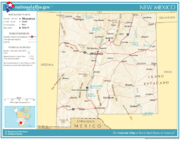
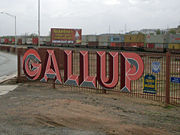
The automobile changed the character of New Mexico, marking the start of large scale immigration to the state from elsewhere in the United States. Settlers moving West during the Great Depression and post-World War II American culture immortalized the National Old Trails Highway, later U.S. Route 66. Today, the automobile is heavily relied upon in New Mexico for transportation.
New Mexico had 59,927 route miles of highway as of the year 2000, of which 7,037 receive federal-aid.[43] In that same year there were 1003 miles of freeways, of which 1000 were the route miles of Interstate highways.[44] The former number has increased with the upgrading of roads near Pojoaque, Santa Fe and Las Cruces to freeways.
The fatality rate, in terms of persons killed per 100 million lane miles traveled, in the year 2000 was 1.9 percent. This is approximately the same as Wyoming, but higher than Massachusets (0.8 percent) and lower than Mississippi (2.7 percent).[45] Notable bridges include the Rio Grande Gorge Bridge near Taos. As of 2001, 703 highway bridges, or one percent, were declared "structurally deficient" or "structurally obsolete".[46]
Rail transportation
With the rise of rail transportation many settlements grew or were founded and the state became a tourist destination. As early as 1878, the Atchison, Topeka and Santa Fe promoted tourism in the region with emphasis on Native American imagery.[47]p. 64 Arguably, the most esteemed and famous passenger train in the United States was the Super Chief, which in its heyday traversed New Mexico on its 39 and one half hour journey from Chicago to Los Angeles.
There were 2,354 route miles of railroads in the year 2000, this number will increase with the opening of the Rail Runner's extension to Santa Fe.[48] In addition to local railroads and other tourist lines, the state jointly owns and operates a heritage narrow-gauge steam railroad, the Cumbres and Toltec Scenic Railway, with the state of Colorado. Narrow-gage railroads once connected many communities in the northern part of the state.
Freight
New Mexico is served by two class I railroads, the Burlington Northern and Santa Fe and the Union Pacific. Combined, they operate 2,200 route miles of railway in this state.[49]
Passenger

With the demise of most intercity rail service in the United States in the late 1960s, New Mexico was left with minimal services. Amtrak, the new state-owned provider, began operating the two extant routes. Resurrection of passenger rail service from Denver to El Paso has been proposed.
Amtrak's Southwest Chief passes through daily at stations in Gallup, Albuquerque, Lamy, Las Vegas, and Raton, offering connections to Los Angeles, Flagstaff, Kansas City, and Chicago. The Sunset Limited makes stops three times a week in Lordsburg, and Deming.
Though described as a commuter rail operation, the New Mexico Rail Runner Express will connect the state's capitol to its largest city. Actually, the BNSF's entire line from Belen to Raton was sold to the state, partially for the construction of phase II of this operation, which is currently underway and scheduled to open by late 2008. It will extend the line northward to Santa Fe. The proposed schedules call for eight weekday Albuquerque—Santa Fe roundtrips with extra Friday evening service and seven Saturday roundtrips.[50][51]
Air transportation
- See also: List of airports in New Mexico
The Albuquerque International Sunport is the state's primary port of entry for air transportation.
Space transportation
Upham, near Truth or Consequences is the location of the world's first commercial spaceport, Spaceport America. It is undeveloped and has one tenant, UP Aerospace, launching small payloads.[52] Virgin Galactic, a space tourism company plans to make this their primary operating base.[53]
Law & government
The Constitution of 1912, as amended, dictates the form of government in the state.
Governor Bill Richardson and Lieutenant Governor Diane Denish, both Democrats, won re-election in 2006. Their terms expire in January 2011. Governors serve a term of four years and may seek reelection for one additional term (limit of two terms). For a list of past governors, see List of New Mexico Governors.
Other constitutional officers, all of whose terms also expire in January 2011, include Secretary of State Mary Herrera,[54] Attorney General Gary King,[55] State Auditor Hector Balderas,[56] State Land Commissioner Patrick H. Lyons,[57] and State Treasurer James B. Lewis.[58] Herrera, King, Balderas and Lewis are Democrats. Lyons is a Republican.
The New Mexico State Legislature is comprising a 70-seat House of Representatives and a 42-seat Senate.
New Mexico sent Democrat Jeff Bingaman to the United States Senate until January 2013 and Republican Pete V. Domenici until January 2009. Republicans Steve Pearce and Heather Wilson and Democrat Tom Udall represent the state in the United States House of Representatives. See New Mexico congressional map.
Politics
At the federal level of government New Mexico has three representatives, Republicans Heather Wilson and Steve Pearce, and Democratic senator-elect Tom Udall. New Mexico has two longtime senators, retiring Republican Pete V. Domenici, who joined the Senate in 1973, and Democrat Jeff Bingaman, who has served since 1983. The congressmen-elect are Martin Heinrich, Harry Teague and Ben R. Luján, all are Democrats.
In the past, New Mexico has given its electoral votes to all but two Presidential election winners since statehood. In these exceptions, New Mexicans supported Republican President Gerald Ford over Georgia Governor Jimmy Carter in 1976, and Democratic Vice President Al Gore over Texas Governor George W. Bush in 2000.
Recently, New Mexico supported Democrats in 1992, 1996, and 2000. In 2004, George W. Bush narrowly won the state's electoral votes by a margin of 0.8 percentage points with 49.8% of the vote. However, in 2008, Democrat Barack Obama won the state with 57% of the vote, defeating John McCain of the neighboring state of Arizona.
Democrats hold majorities in 21 of the 33 counties of New Mexico, including Albuquerque, Las Cruces, two northwestern counties, and, by large margins, in six counties of Northern New Mexico (Santa Fe, Rio Arriba, Taos, Mora, San Miguel, and Guadalupe).
The Democratic Party generally dominates state politics, and as of 2008, 50% of voters were registered Democrats, 33% were registered Republicans, and 15% did not affiliate with either of the two major parties.
Education
Secondary education
Colleges and universities
Culture
- See also: List of people from New Mexico

With a Native American population of 134,000 in 1990, New Mexico still ranks as an important center of American Indian culture. Both the Navajo and Apache share Athabaskan origin. The Apache and some Ute live on federal reservations within the state. With 16 million acres (6,500,000 ha), mostly in neighboring Arizona, the reservation of the Navajo Nation ranks as the largest in the United States. The prehistorically agricultural Pueblo Indians live in pueblos scattered throughout the state, many older than any European settlement.
More than one-third of New Mexicans claim Hispanic origin, the vast majority of whom descend from the original Spanish colonists in the northern portion of the state. Most of the considerably fewer recent Mexican immigrants reside in the southern part of the state.
There are many New Mexicans who also speak a unique dialect of Spanish. New Mexican Spanish has vocabulary often unknown to other Spanish speakers. Because of the historical isolation of New Mexico from other speakers of the Spanish language, the local dialect preserves some late medieval Castilian vocabulary considered archaic elsewhere, adopts numerous Native American words for local features, and contains much Anglicized vocabulary for American concepts and modern inventions.
The presence of various indigenous Native American communities, the long-established Spanish and Mexican influence, and the diversity of Anglo-American settlement in the region, ranging from pioneer farmers and ranchers in the territorial period to military families in later decades, make New Mexico a particularly heterogeneous state.
There are natural history and atomic museums in Albuquerque, which also hosts the famed Albuquerque International Balloon Fiesta.
Art & literature
A large artistic community thrives in Santa Fe. The capital city has museums of Spanish colonial, international folk, Navajo ceremonial, modern Native American, and other modern art. Another museum honors late resident Georgia O'Keeffe. Colonies for artists and writers thrive, and the small city teems with art galleries. In August, the city hosts the annual Santa Fe Indian Market, which is the oldest and largest juried Native American art showcase in the world.
Performing arts include the renowned Santa Fe Opera which presents five operas in repertory each July to August, the Santa Fe Chamber Music Festival held each summer, and the restored Lensic Theater a principal venue for many kinds of performances. The weekend after Labor Day boasts the burning of Zozobra, a 50 ft (15 m) marionette, during Fiestas de Santa Fe.
Writer D. H. Lawrence lived near Taos in the 1920s at the D. H. Lawrence Ranch where there is a shrine said to contain his ashes.
Sports
Notable professional sports teams based in New Mexico include the professional teams Albuquerque Isotopes (baseball), Albuquerque Thunderbirds (basketball), New Mexico Scorpions (ice hockey), and the New Mexico Wildcats (indoor football). The state universities field teams in many sports; teams include the University of New Mexico Lobos and the New Mexico State Aggies.
Olympic gold medalist Tom Jager, who is an advocate of contoversial high-altitude training for swimming, has conducted training camps in Albuquerque (elevation 5,312 ft (1,619.1 m)) and Los Alamos (7320 ft (2,231 m)).[59]
See also
- List of New Mexico-related topics
References
- ↑ http://www.census.gov/popest/states/NST-ann-est.html 2007 Population Estimates
- ↑ 2.0 2.1 "Elevations and Distances in the United States". U.S Geological Survey (29 April 2005). Retrieved on November 6, 2006.
- ↑ 3.0 3.1 (February 2007). "The American Community—Hispanics: 2004" (PDF). US Census Bureau. Retrieved on 2008-10-18.
- ↑ "The American Indian and Alaska Native Population: 2000" (pdf). United States Census Bureau (2002). Retrieved on 2007-08-05.
- ↑ "New Mexico". National Park Service. Retrieved on 2008-07-17.
- ↑ 6.0 6.1 Murphy, Dan (2000). New Mexico, the distant land: an illustrated history. photo research by John O. Baxter (2000 edition ed.). Sun Valley, CA: American Historical Press. ISBN 9781892724090.
- ↑ 7.00 7.01 7.02 7.03 7.04 7.05 7.06 7.07 7.08 7.09 7.10 7.11 Simmons, Marc (1988). New Mexico: An Interpretive History (New Edition ed.). Albuquerque: University of New Mexico Press. ISBN 0826311105.
- ↑ "Cuarto Centenario: 400 Years of New Mexico Culture and History". New Mexico Department of Cultural Affairs (1999). Retrieved on 2008-10-12.
- ↑ 9.0 9.1 Simmons, Mark (1991). The Last Conquistador: Juan De Oñate and the Settling of the Far Southwest. Norman: University of Oklahoma Press. ISBN 0806123680.
- ↑ "The Founding of Albuquerque - The Albuquerque Museum". City of Albuquerque. Retrieved on 2008-10-12.
- ↑ "Texas Annexation Questions and Answers". Texas State Library and Archives Commission. Retrieved on 2008-10-12.
- ↑ "Boundaries of the Louisiana Purchase as Recognized Today". Louisiana: European Explorations and the Louisiana Purchase. Library of Congress (December 2001). Retrieved on 6 December 2008.
- ↑ 13.0 13.1 "Table 16. Population: 1790 to 1990" (PDF). Population and Housing Unit Counts. 1990 Census of Population and Housing. CPH-2-1. U. S. Department of Commerce, Bureau of the Census. pp. 26–27. http://www.census.gov/prod/cen1990/cph2/cph-2-1-1.pdf. Retrieved on 2008-07-03.
- ↑ 14.0 14.1 14.2 14.3 "Annual Estimates of the Population for the United States, Regions, States, and Puerto Rico: April 1, 2000 to July 1, 2007 (NST-EST2007-01)". US Census Bureau, Population Division (2007-12-27). Retrieved on 2008-06-25.
- ↑ Reynis, Lee A.; Marshall J. Vest (2005). "The Southwest Heartland: The Good, the Bad & the Ugly" (PDF) 12. University of New Mexico, Bureau of Business and Economic Research. Retrieved on 2008-10-12.
- ↑ "Population and Population Centers by State: 2000". United States Census Bureau. Retrieved on 2008-12-06.
- ↑ "Table 4: Annual Estimates of the Population for Incorporated Places in New Mexico, Listed Alphabetically: April 1, 2000 to July 1, 2007 (SUB-EST2007-04-35)" (CSV). US Census Bureau, Population Division (2008-07-10). Retrieved on 2008-07-17.
- ↑ "Annual Estimates of the Population for Counties of New Mexico: April 1, 2000 to July 1, 2007 (CO-EST2007-01-35)". US Census Bureau, Population Division (2008-03-20). Retrieved on 2008-06-25.
- ↑ "Table 3: Annual Estimates of the Population by Sex, Race, and Hispanic Origin for New Mexico: April 1, 2000 to July 1, 2007" (CSV). US Census Bureau (2008-05-01). Retrieved on 2008-11-08.
- ↑ Brittingham, Angela; G. Patricia de la Cruz (June 2004). "Table 3. Largest Ancestries for the United States, Regions, States, and for Puerto Rico: 2000" (PDF). Ancestry: 2000; Census 2000 Brief. US Census Bureau. Retrieved on 2008-11-08.
- ↑ MLA Language Map Data Center: Most spoken languages in New Mexico
- ↑ "Language Rights and New Mexico Statehood", The Excluded Student: Educational Practices Affecting Mexican Americans in the Southwest, Mexican American Education Study, Report III, Washington, D.C.: U.S. Government Printing Office, 1972, pp. 76-82
- ↑ Collected by the Association of Statisticians of American Religious Bodies (ASARB) and distributed by the Association of Religion Data Archives. "State Membership Report: New Mexico. Religious Congregations and Membership in the United States, 2000.". Retrieved on 2008-09-19.
- ↑ Pew Forum on Religion & Public Life. (February 2008). "U.S. Religious Landscape Survey: Religious Affiliation: Diverse and Dynamic" (PDF). Pew Research Center. Retrieved on 2008-06-25.
- ↑ "New Mexico Gross Domestic Product by Industry". University of New Mexico, Bureau of Business and Economic Research (2008-06-11). Retrieved on 2008-10-09.
- ↑ "Per Capita Personal Income by State". University of New Mexico, Bureau of Business and Economic Research (2008-04-04). Retrieved on 2008-10-13.
- ↑ "Persons Below Poverty by New Mexico County". University of New Mexico, Bureau of Business and Economic Research (2008-01-18). Retrieved on 2008-10-13.
- ↑ "Travel Economic Impact Model". New Mexico Tourism Department. Retrieved on 2008-10-02.
- ↑ "EIA State Energy Profiles: New Mexico". US Department of Energy, Energy Information Administration (2008-10-09). Retrieved on 2008-10-09.
- ↑ "Oil & Gas Program". New Mexico Institute of Technology, New Mexico Bureau of Geology and Mineral Resources. Retrieved on 2008-10-09.
- ↑ "Federal Spending Received Per Dollar of Taxes Paid by State, 2005". Tax Foundation (2007-10-09). Retrieved on 2008-09-21.
- ↑ Dr. Chris Erickson; Erin Ward (May 2005). "Economic Impact of the Closure of Cannon Air Force Base". New Mexico Business Outlook. New Mexico State University. Retrieved on 2008-10-13.
- ↑ "Business Assistance: Incentives". State of New Mexico Economic Development Department. Retrieved on 2008-06-02.
- ↑ Domrzalski, Dennis (2003-09-19), "28 New Mexico towns tap into $45M in incentives", New Mexico Business Weekly, OCLC 30948175, http://www.bizjournals.com/albuquerque/stories/2003/09/22/story2.html, retrieved on 2008-06-02
- ↑ "Governor Signs Film Production Tax Incentives". New Mexico Economic Development Department (March 4, 2002). Retrieved on 2007-09-12.
- ↑ "New Mexico's Film Incentives". New Mexico Film Office. Retrieved on 2008-06-02.
- ↑ Hay, Kiera (2007-12-10), State's Incentives Keep Film Industry Growing, Albuquerque Journal, OCLC 9392114, http://www.abqjournal.com/AED/268427business12-10-07.htm, retrieved on 2008-06-02
- ↑ "Personal Income Tax Rates" (PDF) 3. State of New Mexico Taxation and Revenue Department (2008-08-25). Retrieved on 2008-09-04.
- ↑ Office of the Governor, State of New Mexico (2008-06-14). "Governor Richardson Announces New Laws to Take Effect; New State laws go into effect June 15, 2007" (PDF). Press release. Retrieved on 2008-09-05. “HB 436 Working Families Tax Credit...eliminates taxes on active duty military salaries.”
- ↑ "Gross Receipts Taxes FAQ". State of New Mexico, Taxation and Revenue Department (2006-08-06). Retrieved on 2008-10-09.
- ↑ "Gross Receipts Tax Rate Schedule, Effective July 1, 2008 through December 31, 2008". State of New Mexico, Taxation and Revenue Department (2008-06-05). Retrieved on 2008-10-09.
- ↑ "Property Tax FAQ". State of New Mexico, Taxation and Revenue Department (2007-08-07). Retrieved on 2008-10-09.
- ↑ U.S. Department of Transportation Bureau of Transportation Statistics, Table 1-2: New Mexico Public Road Length, Miles by Ownership 2000[1]
- ↑ U.S. Department of Transportation Bureau of Transportation Statistics, Table 1-1: New Mexico Public Road Length, by Functional System [2]
- ↑ U.S. Department of Transportation Bureau of Transportation Statistics, Table 2-1: Highway Traffic Fatalities and Fatality Rates: 2000[3]
- ↑ U.S. Department of Transportation Bureau of Transportation Statistics, Table 1-5: Highway Bridge Condition: 2001 [4]
- ↑ Richards, C Fenton Jr & Robert Strein & John Vaughn (2001). Santa Fe - The Chief Way. Second Printing, 2005. New Mexico Magazine. ISBN 0-937206-71-7.
- ↑ U.S. Department of Transportation Bureau of Transportation Statistics,Table 1-9: Freight Railroads in New Mexico and the United States: 2000 [5]
- ↑ U.S. Department of Transportation Bureau of Transportation Statistics,Table 1-9: Freight Railroads in New Mexico and the United States: 2000[6]
- ↑ "Draft Saturday Schedule" page on Rail Runner website
- ↑ "Revised Weekday Interim Schedule" page on Rail Runner website
- ↑ UP Aerospace does launches ‘quickly and cheaply’, DenverBiz Journal, October 2008 [7]
- ↑ "News Release 03.04.2008 / Spaceport Sweden and Virgin Galactic". Retrieved on 2008-06-26.
- ↑ NM Secretary of State's Office official web site
- ↑ NM Attorney General's Office official web site
- ↑ NM State Auditor's Office official web site
- ↑ NM State Lands official web site
- ↑ NM State Treasuer's Office official web site
- ↑ "High Hopes: Altitude Training for Swimmers", by Michael Scott, SwimmingworldMagazine.com magazine archives[8] (10-15-08)
Further reading

- Hubert Howe Bancroft. The Works of Hubert Howe Bancroft, Vol. XVII. (History of Arizona and New Mexico 1530-1888) (1889); reprint 1962. online edition
- Warren Beck. Historical Atlas of New Mexico 1969.
- Thomas E. Chavez, An Illustrated History of New Mexico, 267 pages, University of New Mexico Press 2002, ISBN 0-8263-3051-7
- Joseph G. Dawdon III. Doniphan's Epic March; The 1st Missouri Volunteers in the Mexican War, Kansas Press [9]
- Richard Ellis, ed. New Mexico Past and Present: A Historical Reader. 1971. primary sources
- Lynne Marie Getz; Schools of Their Own: The Education of Hispanos in New Mexico, 1850-1940 (1997)
- Erlinda Gonzales-Berry, David R. Maciel, editors, The Contested Homeland: A Chicano History of New Mexico, 314 pages - University of New Mexico Press 2000, ISBN 0-8263-2199-2
- Nancie L. González; The Spanish-Americans of New Mexico: A Heritage of Pride (1969)
- Ramón A. Gutiérrez; When Jesus Came, the Corn Mothers Went Away: Marriage, Sexuality, and Power in New Mexico, 1500-1846 (1991)
- Paul L. Hain; F. Chris Garcia, Gilbert K. St. Clair; New Mexico Government 3rd ed. (1994)
- Tony Hillerman, The Great Taos Bank Robbery and other Indian Country Affairs, University of New Mexico Press, Albuquerque, 1973, trade paperback, 147 pages, (ISBN 0-8263-0530-X), stories
- Jack E. Holmes, Politics in New Mexico (1967),
- Paul Horgan, Great River, The Rio Grande in North American History, 1038 pages, Wesleyan University Press 1991, 4th Reprint, ISBN 0585380147, Pulitzer Prize 1955
- Sante Fe Trail: 72 References Kansas Historical Society [10]
- Robert W. Kern, Labor in New Mexico: Strikes, Unions, and Social History, 1881-1981, University of New Mexico Press 1983, ISBN 0-8263-0675-6
- Howard R. Lamar; The Far Southwest, 1846-1912: A Territorial History (1966, repr 2000)
- Robert W. Larson, New Mexico's Quest for Statehood, 1846-1912 (1968)
- John M. Nieto-Phillips, The Language of Blood: The Making of Spanish-American Identity in New Mexico, 1880s-1930s, University of New Mexico Press 2004, ISBN 08236324231
- Marc Simmons, New Mexico: An Interpretive History, 221 pages, University of New Mexico Press 1988, ISBN 0-8263-1110-5
- George I. Sánchez; Forgotten People: A Study of New Mexicans (1940; reprint 1996)
- Marc Simmons, New Mexico: An Interpretive History, 221 pages, University of New Mexico Press 1988, ISBN 0-8263-1110-5, good introduction
- Ferenc M. Szasz; and Richard W. Etulain; Religion in Modern New Mexico (1997)
- David J. Weber, The Mexican Frontier, 1821-1846: The American Southwest under Mexico (1982)
- David J. Weber; Foreigners in Their Native Land: Historical Roots of the Mexican Americans (1973), primary sources to 1912
External links
- State Government
- New Mexico Government
- New Mexico's Blue Book On-Line - State of New Mexico, Secretary of State (print almanac of statistics and information)
- Bureau of Elections New Mexico Major and Minor Political Parties
- New Mexico State Databases - Annotated list of searchable databases produced by New Mexico state agencies and compiled by the Government Documents Roundtable of the American Library Association.
- Bureau of Business and Economic Research (BBER) at University of New Mexico (statistical information about the New Mexico economy)
- U.S. Government
- Energy Profile for New Mexico- Economic, environmental, and energy data
- New Mexico - Science In Your Backyard - United States Geological Society
- "American Southwest" - Discover Our Shared Heritage travel itinerary - National Park Service
- New Mexico dataset - United States Census Bureau
- New Mexico state facts - Economic Research Service - United States Department of Agriculture
- Directory
- New Mexico at the Open Directory Project
- Tourism
- New Mexico travel guide from Wikitravel
|
|
||||||||||||||
|
||||||||
| Preceded by Oklahoma |
List of U.S. states by date of statehood Admitted on January 6, 1912 (47th) |
Succeeded by Arizona |

